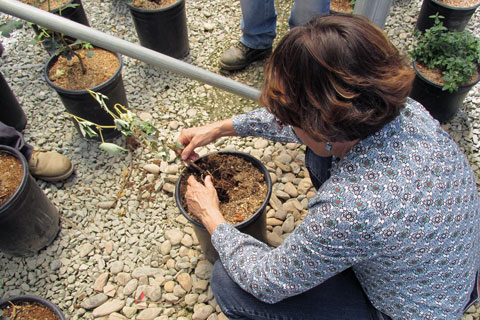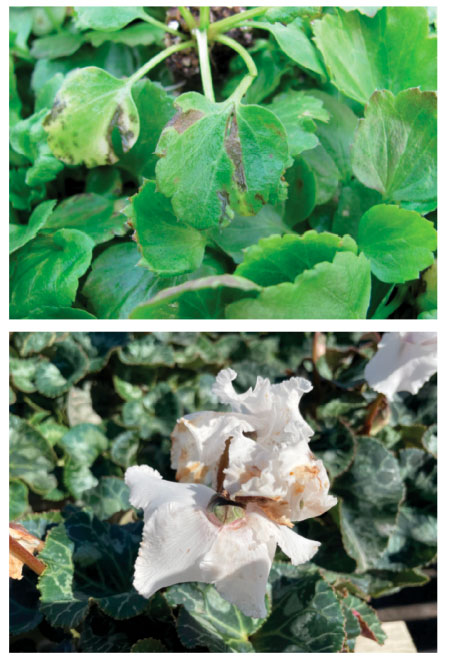2/1/2022
Branded vs. Generic
A.R. Chase

The most important choice in disease control is what product to use. You first need to know what disease you’re trying to prevent or cure. Then you need to choose an appropriate product—one that works. If you opt to simply choose products based on their cost per unit (package, not plant) you may be successful and you may not. In some cases, you’ll have effective and safe control, while in others, the brand name fungicide will be more effective or safer than a post-patent or generic product. That can lead to a better value or ROI (return on investment) with a brand-name product. The question of post-patent fungicides vs. brand-name fungicides is yet another example of having to know more than perhaps you would like.
Pictured: The author helping growers diagnose a disease issue.
We need to ask ourselves, how much risk are we willing to take? Can we deal with the repercussions? How much of a setback will it create if our choices lead to a crop failure? How much money can we gamble with?
Not only are we faced with making wise choices in our businesses, but in our everyday lives—take prescription meds, household cleaners, tires and many, many other products. We’ve all heard the phrase, “You get what you pay for”—well, it does apply in most cases. As stated above, usually there’s some sort of disclaimer involved if we read the fine print or do a little investigating. This is where we have to or should do our homework, and for the most part it is up to us. How many of us spend the time figuring out what the differences are? Or do we say just go with the generics because they’re cheaper?
Brand-name vs. post-patent
Why do I recommend only brand-name fungicides and bactericides? Primarily, it’s because I base all of my recommendations on trial work that I try to verify with grower experience. Being a scientist, I favor research over testimonials. I want my suggestions to be successful and not based on smoke and mirrors.
Over the past few decades, we’ve seen an influx of post-patent fungicides enter the ornamental market place. Generic versions are available very soon after the expiration of patents on proprietary fungicide products. They’re usually less costly and have a very similar label to the brand-name fungicides we’re familiar with. Comparisons of products with similar active ingredients (such as phosphonates or coppers) are rare. We also rarely see a trial comparing a pre-patent, brand-name product with post-patent, generic formulations. The companies that sell post-patent/generic fungicides don’t routinely trial their products against the better-known trade name fungicide.
 Who would fund these trials? Nobody really wants to make the comparisons obvious, as it could interfere with marketing efforts—what if they all work the same? What if they show one group is better than the other (brand names vs. generics)? You’ve heard, “Keep your mouth shut. Being assumed wrong is better than speaking and proving it.” However, these types of trials are hard to find since so few are published.
Who would fund these trials? Nobody really wants to make the comparisons obvious, as it could interfere with marketing efforts—what if they all work the same? What if they show one group is better than the other (brand names vs. generics)? You’ve heard, “Keep your mouth shut. Being assumed wrong is better than speaking and proving it.” However, these types of trials are hard to find since so few are published.
Pictured left top: Watch for Xanthomonas on ranunculus during the winter.
Left bottom: Botrytis causes leaf damage and flower spots on cyclamen in the winter.
That hasn’t stopped me from doing some of this work on fungicides and bactericides. The results have indicated that the brand-name products are sometimes formulated in a way to maximize their efficacy. For example, I’ve seen repeatedly that certain fungicides are more effective and safer to the crop in an older, wettable powder formulation than a flowable formulation. So not only do we see differences between branded and generics in efficacy and safety, but even between different formulations of branded products with the same active ingredient.
There are a number of companies that are providing our industry with products. Some of them also have brand-name products. I wouldn’t say I actually could identify a “generics-only” company.
Generic products by law have the same amount of active ingredient as the original brand-name fungicides. However, there may be differences in inert ingredients or formulations. Generic products are often less costly for a variety of reasons including:
• Minimal research needed (sometimes none)
• Marketing costs are minimally needed as the brand name has been marketed for years
• Formulation chemistry might be less costly
• Labels are the same (and therefore already accomplished) by the brand name company’s efforts
The benefits of using branded products include:
• Knowing the chemistry (active ingredient and formulation) is exactly what the manufacturer claims
• Having trial data by an independent source (like universities) to verify the product efficacy AND safety
• Access to a support team to call if there’s a problem
Even if the company producing a generic product does have a good support team, they often have little or no experience with their product and the actual history of development is not available to them.
New active ingredients aren’t always better than standards that have been around for decades. However, in the instance of resistance management, it’s always helpful to use new products (especially if they’re in a new FRAC group) when available. And the results have indicated that the trade-name products sometimes are formulated with better efficacy than their generic counterparts.
If we simply chose to buy the least-costly product, we’ll eventually see only older products in generic forms—no new brand-name products. As the EPA continues to remove older products from our arsenal, the picture isn’t pretty for pest-control products in ornamentals.
The cost of an unwise choice often extends far into the future. If you rely on a generic product, and it fails or damages the crop, the loss isn’t just the cost of the product. It’s also the cost of the bench space that didn’t yield a saleable crop, the cost of the labor to apply it and the cost of replacing the crop using better inputs. And the ultimate cost is sometimes loss of a customer.
Look into new choices carefully before betting on a cheaper alternative that may end up being more costly. Nothing is more expensive than throwing plants away due to uncontrolled diseases or other pests.
One more thought: If we all jump to generics/post-patent then there’s less money to be made by the brand-name companies and less new products may be pursued. The real problem might be lack of enthusiasm to provide new products for the ornamental industry, which is very small compared to turf and is, in turn, very small compared to agricultural markets. GT
A. R. Chase is a plant pathologist with Chase Agricultural Consulting, LLC. She can be reached at archase@chaseresearch.net.